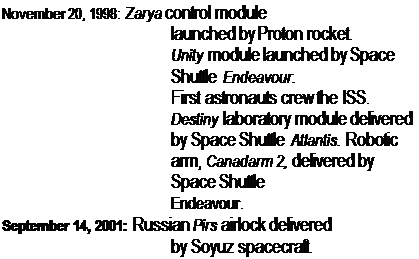International Space Station
|
A |
new era in space exploration began on November 20, 1998, when the first module of the International Space Station (ISS) was launched into space. The space station is an orbital science laboratory and research facility, circling Earth at a height of 200-250 miles (320-400 kilometers). The ISS makes almost sixteen orbits every day-each orbit lasts 91.61 minutes. The space station’s average speed is 17,165 miles per hour (27,620 kilometers per hour). Since 2000, the ISS has been staffed by teams of astronauts.
The Space Station Concept
The term “space station” was first used in 1923 by German writer Hermann
Oberth, who foresaw a giant wheel in space from which astronauts might travel to the Moon and to the other planets. Rocket engineer Wernher von Braun described a similar concept in 1952. Orbital space stations have featured in science fiction books and movies, such as 2001: A Space Odyssey. In many stories, a space station was a spaceport for rockets. These fictional space stations spun like mini-planets, with centrifugal force producing artificial gravity so that the people inside did not float around.
The world’s first real space station, a much smaller structure, was launched in 1971. This was Salyut 1, launched by the Soviet Union. It was followed in 1973 by the first U. S. space station, Skylab,
which was visited by three crews of astronauts. The Soviets flew much longer missions than the Americans,
with some cosmonauts living in orbit for a year or more. In 1986 the Soviet Union
launched Mir, a space station big enough for six people.
In 1995 the U. S.
Space Shuttle Atlantis
docked with Mir, the
О In December 1998, the U. S. module Unity (left) was attached to the Russian module Zarya (right) in the first phase of construction of the ISS.
![]()

![]()
 first time a U. S. spacecraft had linked up with the Russian space station. The modular design of Mir, with its solar panel “wings” and the docking unit used to link with the Shuttle, were forerunners of systems later developed for the International Space Station.
first time a U. S. spacecraft had linked up with the Russian space station. The modular design of Mir, with its solar panel “wings” and the docking unit used to link with the Shuttle, were forerunners of systems later developed for the International Space Station.










